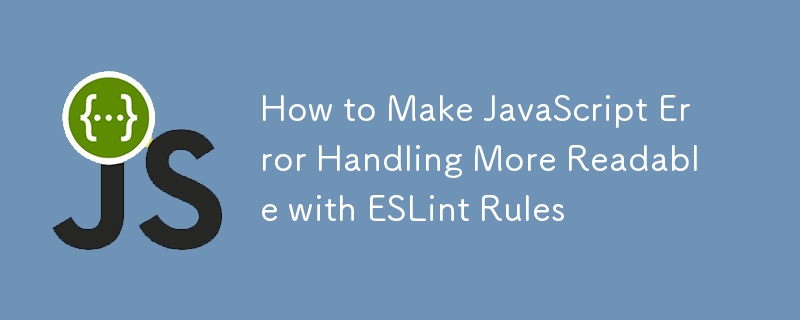ESLint 규칙을 사용하여 JavaScript 오류 처리를 더 읽기 쉽게 만드는 방법
- DDD원래의
- 2024-10-09 06:20:29504검색

Introduction: Mastering Error Handling in JavaScript
Effective error handling is crucial for any robust JavaScript application. It aids in quick issue identification, simplifies debugging, and enhances software reliability. This guide delves into improving JavaScript error handling through ESLint, a tool that enforces code quality and standardizes error handling practices.
Why Focus on Readable Error Handling?
Readable error handling provides immediate insights into issues, helping developers understand and fix problems efficiently. This practice is vital in team environments and crucial for maintaining code in the long term.
Implementing Better Error Handling Practices
To enhance your JavaScript error handling, consider the following strategies:
1. Use Try-Catch Blocks Effectively
try {
const data = JSON.parse(response);
console.log(data);
} catch (error) {
console.error("Failed to parse response:", error);
}
2. Develop Custom Error Classes
class ValidationError extends Error {
constructor(message) {
super(message);
this.name = "ValidationError";
}
}
try {
throw new ValidationError("Invalid email address");
} catch (error) {
console.error(error.name, error.message);
}
3. Ensure Detailed Error Logging
function handleError(error) {
console.error(`${new Date().toISOString()} - Error: ${error.message}`);
}
4. Differentiate Throwing and Non-Throwing Functions
Throwing version:
function calculateAge(dob) {
if (!dob) throw new Error("Date of birth is required");
}
Non-throwing version:
function tryCalculateAge(dob) {
if (!dob) {
console.error("Date of birth is required");
return null;
}
}
Enforcing Error Handling with ESLint
Setting up ESLint to enforce these practices involves the following steps and configurations:
1. Install and Set Up ESLint
npm install eslint --save-dev npx eslint --init
2. Configure ESLint Rules for Error Handling
Effective error handling is essential for developing robust JavaScript applications. Below are ESLint rules that can help enforce good error handling practices in your codebase.
1. No Unhandled Promises
- Rule:
"promise/no-return-in-finally": "warn", "promise/always-return": "error"
- Explanation: This configuration ensures that promises always handle errors and don’t unintentionally suppress returned values in finally blocks.
2. No Await Inside a Loop
- Rule:
"no-await-in-loop": "error"
- Explanation: Awaits inside loops can lead to performance issues, as each iteration waits for a promise to resolve sequentially. It's better to use Promise.all() for handling multiple promises.
- Example:
// Incorrect
async function processArray(array) {
for (let item of array) {
await processItem(item);
}
}
// Correct
async function processArray(array) {
const promises = array.map(item => processItem(item));
await Promise.all(promises);
}
3. Proper Error Handling in Async Functions
- Rule:
"promise/catch-or-return": "error", "async-await/space-after-async": "error"
- Explanation: Enforce that all asynchronous functions handle errors either by catching them or by returning the promise chain.
4. Consistent Return in Functions
- Rule:
"consistent-return": "error"
- Explanation: This rule enforces a consistent handling of return statements in functions, making it clear whether functions are expected to return a value or not, which is crucial for error handling and debugging.
5. Disallowing Unused Catch Bindings
- Rule:
"no-unused-vars": ["error", {"args": "none"}],
"no-unused-catch-bindings": "error"
- Explanation: Ensures that variables declared in catch blocks are used. This prevents ignoring error details and encourages proper error handling.
6. Enforce Throwing of Error Objects
- Rule:
"no-throw-literal": "error"
- Explanation: This rule ensures that only Error objects are thrown. Throwing literals or non-error objects often leads to less informative error messages and harder debugging.
- Example:
// Incorrect
throw 'error';
// Correct
throw new Error('An error occurred');
7. Limiting Maximum Depth of Callbacks
- Rule:
"max-nested-callbacks": ["warn", 3]
- Explanation: Deeply nested callbacks can make code less readable and error-prone. Limiting the nesting of callbacks encourages simpler, more maintainable code structures.
8. Avoiding Unused Expressions in Error Handling
- Rule:
"no-unused-expressions": ["error", {"allowShortCircuit": true, "allowTernary": true}]
- Explanation: This rule aims to eliminate unused expressions which do not affect the state of the program and can lead to errors being silently ignored.
9. Require Error Handling in Callbacks
- Rule:
"node/handle-callback-err": "error"
- Explanation: Enforces handling error parameters in callbacks, a common pattern in Node.js and other asynchronous JavaScript code.
10. Disallowing the Use of Console
- Rule:
"no-console": "warn"
- Explanation: While not strictly an error handling rule, discouraging the use of console helps in avoiding leaking potentially sensitive error details in production environments and encourages the use of more sophisticated logging mechanisms.
3. Integrate ESLint into Your Development Workflow
Ensure ESLint runs automatically before code commits or during CI/CD processes.
Conclusion: Enhancing Code Quality with ESLint
By adopting these ESLint rules and error-handling strategies, you elevate the readability and reliability of your JavaScript applications. These improvements facilitate debugging and ensure a smoother user experience.
Final Thought
Are you ready to transform your error handling approach? Implement these practices in your projects to see a significant boost in your development efficiency and code quality. Embrace these enhancements and lead your projects to success.
위 내용은 ESLint 규칙을 사용하여 JavaScript 오류 처리를 더 읽기 쉽게 만드는 방법의 상세 내용입니다. 자세한 내용은 PHP 중국어 웹사이트의 기타 관련 기사를 참조하세요!

